Liquid Crystal@Nanosilver Catalytic Amplification—Aptamer Trimode Biosensor for Trace Pb2+
Abstract
:1. Introduction
2. Results and Discussion
2.1. Analysis Principle
2.2. Nanomaterial Characterization
2.2.1. Transmission Electron Microscope of AgNPs and CB@AgNPs
2.2.2. Molecular Spectrum, Zeta Potential and Particle Size Distribution of CB, AgNPs and CB@AgNPs
2.3. SERS Spectra of a Nanocatalytic System
2.4. RRS Spectra of a Catalytic Amplification System
2.5. Abs Spectra of a Catalytic Amplification System
2.6. CB@AgNPs and LC Catalytic Mechanism
2.7. Optimization of Analysis Conditions
2.8. Working Curve
2.9. Influence of Interfering Ions
2.10. Sample Determination
3. Materials and Methods
3.1. Main Instruments
3.2. Main Reagents
3.3. Experimental Procedure
4. Conclusions
Supplementary Materials
Author Contributions
Funding
Data Availability Statement
Conflicts of Interest
References
- Bai, Y.; Abbott, N.L. Recent Advances in Colloidal and Interfacial Phenomena Involving Liquid Crystals. Langmuir 2010, 27, 5719–5738. [Google Scholar] [CrossRef]
- Jiang, Y.; Li, D.; Chen, Y.; Huo, Y. Analysis of stress and strain concentration around a centralized elliptical hole in a monodomain liquid crystal elastomer sheet. Int. J. Solids Struct. 2023, 264, 112079. [Google Scholar] [CrossRef]
- Chawla, M.; Kumar, R.; Siril, P.F. High catalytic activities of palladium nanowires synthesized using liquid crystal templating approach. J. Mol. Catal. A Chem. 2016, 423, 126–134. [Google Scholar] [CrossRef]
- Kato, T.; Yoshio, M.; Ichikawa, T.; Soberats, B.; Ohno, H.; Funahashi, M. Transport of ions and electrons in nanostructured liquid crystals. Nat. Rev. Mater. 2017, 2, 17001. [Google Scholar] [CrossRef]
- Rouhbakhsh, Z.; Verdian, A.; Rajabzadeh, G. Design of a liquid crystal-based aptasensing platform for ultrasensitive detection of tetracycline. Talanta 2019, 206, 120246. [Google Scholar] [CrossRef]
- Qi, L.; Hu, Q.; Kang, Q.; Bi, Y.; Jiang, Y.; Yu, L. Detection of Biomarkers in Blood Using Liquid Crystals Assisted with Aptamer-Target Recognition Triggered in Situ Rolling Circle Amplification on Magnetic Beads. Anal. Chem. 2019, 91, 11653–11660. [Google Scholar] [CrossRef] [PubMed]
- Wang, Y.; Wang, B.; Shen, J.; Xiong, X.; Deng, S. Aptamer based bare eye detection of kanamycin by using a liquid crystal film on a glass support. Microchim. Acta 2017, 184, 3765–3771. [Google Scholar] [CrossRef]
- Wang, S.; Zhang, G.; Chen, Q.; Zhou, J.; Wu, Z. Sensing of cocaine using polarized optical microscopy by exploiting the conformational changes of an aptamer at the water/liquid crystal interface. Microchim. Acta 2019, 186, 724. [Google Scholar] [CrossRef]
- Verdian, A.; Rouhbakhsh, Z.; Fooladi, E. An ultrasensitive platform for PCB77 detection: New strategy for liquid crystal-based aptasensor fabrication. J. Hazard. Mater. 2020, 402, 123531. [Google Scholar] [CrossRef]
- Pourmostafa, D.; Tajalli, H.; Vahedi, A.; Milanchian, K. Electro-optical Kerr effect of 6CHBT liquid crystal doped with MgO nanoparticles in different concentration. Opt. Mater. 2020, 107, 110061. [Google Scholar] [CrossRef]
- Budaszewski, D.; Chychłowski, M.; Budaszewska, A.; Bartosewicz, B.; Jankiewicz, B.; Wolinski, T. Enhanced efficiency of electric field tunability in photonic liquid crystal fibers doped with gold nanoparticles. Opt. Express 2019, 27, 14260–14269. [Google Scholar] [CrossRef] [PubMed]
- Mostafa, M.; Agra-Kooijman, D.M.; Perera, K.; Adaka, A.; West, J.L.; Jákli, A. Colloidal latex/liquid crystal coatings for thermochromic textiles. Colloid Interface Sci. Commun. 2023, 52, 100693. [Google Scholar] [CrossRef]
- Sun, Y.; Li, Z.; Huang, X.; Zhang, D.; Zou, X.; Shi, J.; Zhai, X.; Jiang, C.; Wei, X.; Liu, T. A nitrile-mediated aptasensor for optical anti-interference detection of acetamiprid in apple juice by surface-enhanced Raman scattering. Biosens. Bioelectron. 2019, 145, 111672. [Google Scholar] [CrossRef] [PubMed]
- Liu, Y.; Tian, H.; Chen, X.; Liu, W.; Xia, K.; Huang, J.; de la Chapelle, M.L.; Huang, G.; Zhang, Y.; Fu, W. Indirect surface-enhanced Raman scattering assay of insulin-like growth factor 2 receptor protein by combining the aptamer modified gold substrate and silver nanoprobes. Microchim. Acta 2020, 187, 1–9. [Google Scholar] [CrossRef] [PubMed]
- Ouyang, H.; Ling, S.; Liang, A.; Jiang, Z. A facile aptamer-regulating gold nanoplasmonic SERS detection strategy for trace lead ions. Sens. Actuators B Chem. 2018, 258, 739–744. [Google Scholar] [CrossRef]
- Santhoshkumar, S.; Murugan, E. Rationally designed SERS AgNPs/GO/g-CN nanohybrids to detect methylene blue and Hg2+ ions in aqueous solution. Appl. Surf. Sci. 2021, 553, 149544. [Google Scholar] [CrossRef]
- El Kurdi, R.; Patra, D. Amplification of resonance Rayleigh scattering of gold nanoparticles by tweaking into nanowires: Bio-sensing of α-tocopherol by enhanced resonance Rayleigh scattering of curcumin capped gold nanowires through non-covalent interaction. Talanta 2017, 168, 82–90. [Google Scholar] [CrossRef]
- El Kurdi, R.; Patra, D. Tuning the surface of Au nanoparticles using poly(ethylene glycol)-block-poly(propylene glycol)-block-poly(ethylene glycol): Enzyme free and label free sugar sensing in serum samples using resonance Rayleigh scattering spectroscopy. Phys. Chem. Chem. Phys. 2018, 20, 9616–9629. [Google Scholar] [CrossRef]
- El-Kurdi, R.; Patra, D. Gold and silver nanoparticles in resonance Rayleigh scattering techniques for chemical sensing and biosensing: A review. Microchim. Acta 2019, 186, 667. [Google Scholar] [CrossRef]
- Li, J.; Wang, S.; Kang, W.; Li, N.; Guo, F.; Chang, H.; Wei, W. Multifunctional gold nanoparticle based selective detection of esophageal squamous cell carcinoma cells using resonance Rayleigh scattering assay. Microchem. J. 2020, 163, 105905. [Google Scholar] [CrossRef]
- Wang, X.; Jiang, X.; Zhang, Z.; Li, J.; Liang, A.; Jiang, Z. A fluorescence and resonance Rayleigh scattering di-model probe was developed for trace K+ coupled N-doped carbon dot and aptamer. J. Lumin. 2019, 214, 116559. [Google Scholar] [CrossRef]
- Yao, D.; Li, C.; Wang, H.; Wen, G.; Liang, A.; Jiang, Z. A new dual-mode SERS and RRS aptasensor for detecting trace organic molecules based on gold nanocluster-doped covalent-organic framework catalyst. Sens. Actuators B Chem. 2020, 319, 128308. [Google Scholar] [CrossRef]
- Huang, H.; Li, J.; Pan, S.; Wang, H.; Liang, A.; Jiang, Z. A novel small molecular liquid crystal catalytic amplification-nanogold SPR aptamer absorption assay for trace oxytetracycline. Talanta 2021, 233, 122528. [Google Scholar] [CrossRef] [PubMed]
- Li, D.; Ma, Y.; Duan, H.; Deng, W.; Li, D. Griess reaction-based paper strip for colorimetric/fluorescent/SERS triple sensing of nitrite. Biosens. Bioelectron. 2018, 99, 389–398. [Google Scholar] [CrossRef] [PubMed]
- Wang, H.; Zhang, Z.; Chen, C.; Liang, A.; Jiang, Z. Fullerene carbon dot catalytic amplification-aptamer assay platform for ultratrace As+3 utilizing SERS/RRS/Abs trifunctional Au nanoprobes. J. Hazard. Mater. 2020, 403, 123633. [Google Scholar] [CrossRef] [PubMed]
- Marbella, L.; Serli-Mitasev, B.; Basu, P. Development of a Fluorescent Pb2+ Sensor. Angew. Chem. Int. Ed. 2009, 48, 3996–3998. [Google Scholar] [CrossRef] [PubMed]
- Chen, K.-J.; Lee, C.-F.; Rick, J.; Wang, S.-H.; Liu, C.-C.; Hwang, B.-J. Fabrication and application of amperometric glucose biosensor based on a novel PtPd bimetallic nanoparticle decorated multi-walled carbon nanotube catalyst. Biosens. Bioelectron. 2012, 33, 75–81. [Google Scholar] [CrossRef]
- Xue, Q.; Guo, R.; Wen, Y.; Wang, L.; Cheng, X.; Liu, G.; Wu, Q. Development of a fluorescence-based DNAzyme biosensor to detect Pb2+ in tobacco leaf extracts for cleaner crop production. J. Clean. Prod. 2022, 362, 132544. [Google Scholar] [CrossRef]
- Nazari, M.; Amini, A.; Eden, N.; Duke, M.; Cheng, C.; Hill, M. Highly-Efficient Sulfonated UiO-66(Zr) Optical Fiber for Rapid Detection of Trace Levels of Pb2+. Int. J. Mol. Sci. 2021, 22, 6053. [Google Scholar] [CrossRef]
- Yu, Z.; Zhou, W.; Han, J.; Li, Y.; Fan, L.; Li, X. Na+-Induced Conformational Change of Pb2+-Stabilized G-Quadruplex and Its Influence on Pb2+ Detection. Anal. Chem. 2016, 88, 9375–9380. [Google Scholar] [CrossRef]
- Wang, H.; Yang, L.; Chu, S.; Liu, B.; Zhang, Q.; Zou, L.; Yu, S.; Jiang, C. Semiquantitative Visual Detection of Lead Ions with a Smartphone via a Colorimetric Paper-Based Analytical Device. Anal. Chem. 2019, 91, 9292–9299. [Google Scholar] [CrossRef]
- Zhuang, J.; Fu, L.; Xu, M.; Zhou, Q.; Chen, G.; Tang, D. DNAzyme-based magneto-controlled electronic switch for picomolar detection of lead (II) coupling with DNA-based hybridization chain reaction. Biosens. Bioelectron. 2013, 45, 52–57. [Google Scholar] [CrossRef] [PubMed]
- Pathinti, R.S.; Gollapelli, B.; Jakka, S.K.; Vallamkondu, J. Green synthesized TiO2 nanoparticles dispersed cholesteric liquid crystal systems for enhanced optical and dielectric properties. J. Mol. Liq. 2021, 336, 116877. [Google Scholar] [CrossRef]
- Yip, W.; Welch, C.; Mehl, G.H.; Wilkinson, T.D. A cholesteric liquid crystal device having stable uniform lying helix structure. J. Mol. Liq. 2020, 299, 112141. [Google Scholar] [CrossRef]
- Li, M.; Zhou, X.; Guo, S.; Wu, N. Detection of lead (II) with a “turn-on” fluorescent biosensor based on energy transfer from CdSe/ZnS quantum dots to graphene oxide. Biosens. Bioelectron. 2013, 43, 69–74. [Google Scholar] [CrossRef] [PubMed]
- Ling, S.M.; Fan, Y.Y.; Jiang, Z.L.; Wen, G.Q.; Liu, Q.Y.; Liang, A.H. Resonance Scattering Spectral Detection of Trace Pb2+ Using Aptamer Modified Nanogold as a Probe. Acta Chim. Sin. 2010, 68, 339–344. (in Chinese). Available online: https://sioc-journal.cn/Jwk_hxxb/CN/Y2010/V68/I04/339 (accessed on 12 December 2022).
- Zhang, B.; Wei, C. Highly sensitive and selective detection of Pb2+ using a turn-on fluorescent aptamer DNA silver nanoclusters sensor. Talanta 2018, 182, 125–130. [Google Scholar] [CrossRef] [PubMed]
- Deng, H.-M.; Huang, L.-J.; Chai, Y.-Q.; Yuan, R.; Yuan, Y.-L. Ultrasensitive Photoelectrochemical Detection of Multiple Metal Ions Based on Wavelength-Resolved Dual-Signal Output Triggered by Click Reaction. Anal. Chem. 2019, 91, 2861–2868. [Google Scholar] [CrossRef]
- Wang, H.-B.; Ma, L.-H.; Fang, B.-Y.; Tan, F.; Cao, Y.-C.; Zhao, Y.-D.; Hu, X.-B. Visual detection of Pb2+ using strip biosensor based on PS2M aptamer and sensitivity enhancement probe. Sens. Actuators B Chem. 2018, 261, 307–315. [Google Scholar] [CrossRef]
- Guerrini, L.; Alvarez-Puebla, R.A. Multiplex SERS Chemosensing of Metal Ions via DNA-Mediated Recognition. Anal. Chem. 2019, 91, 11778–11784. [Google Scholar] [CrossRef]
- Wang, H.; Liang, A.; Wen, G.; Jiang, Z. A simple SPR absorption method for ultratrace Pb2+ based on DNAzyme-COFPd nanocatalysis of Ni-P alloy reaction. Sens. Actuators B Chem. 2021, 330, 129381. [Google Scholar] [CrossRef]
- Feng, D.; Li, P.; Tan, X.; Wu, Y.; Wei, F.; Du, F.; Ai, C.; Luo, Y.; Chen, Q.; Han, H. Electrochemiluminescence aptasensor for multiple determination of Hg2+ and Pb2+ ions by using the MIL-53(Al)@CdTe-PEI modified electrode. Anal. Chim. Acta 2019, 1100, 232–239. [Google Scholar] [CrossRef] [PubMed]
- Lin, W.-F.; Zhai, W.-Y.; Yan, Y.; Liu, Y.-Q. Highly sensitive Pb2+ sensor based on rod-like poly-tyrosine/Bi modified glassy carbon electrode combined with electrodeposition to eliminate Cu2+ interference. Microchem. J. 2020, 160, 105664. [Google Scholar] [CrossRef]
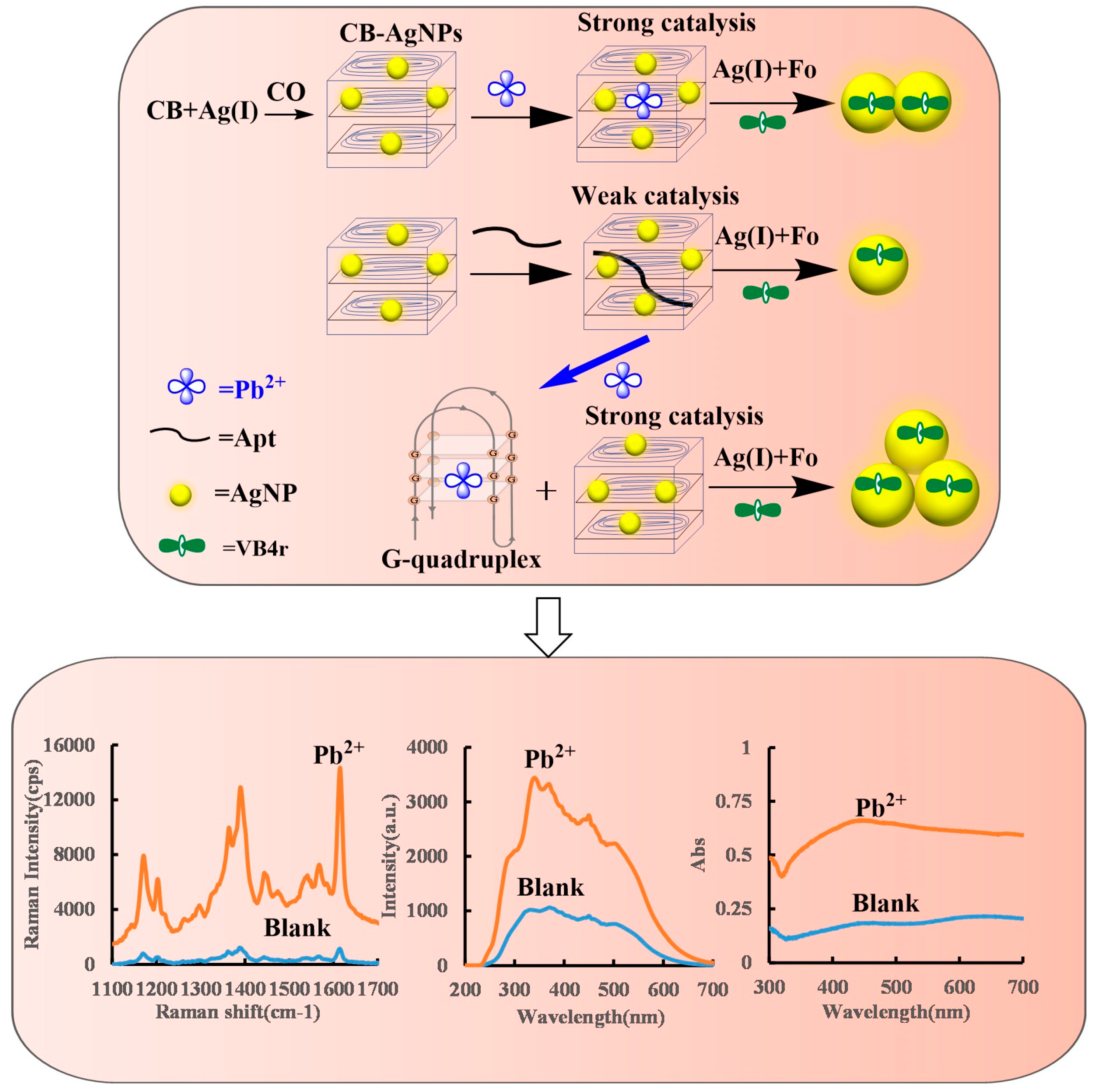

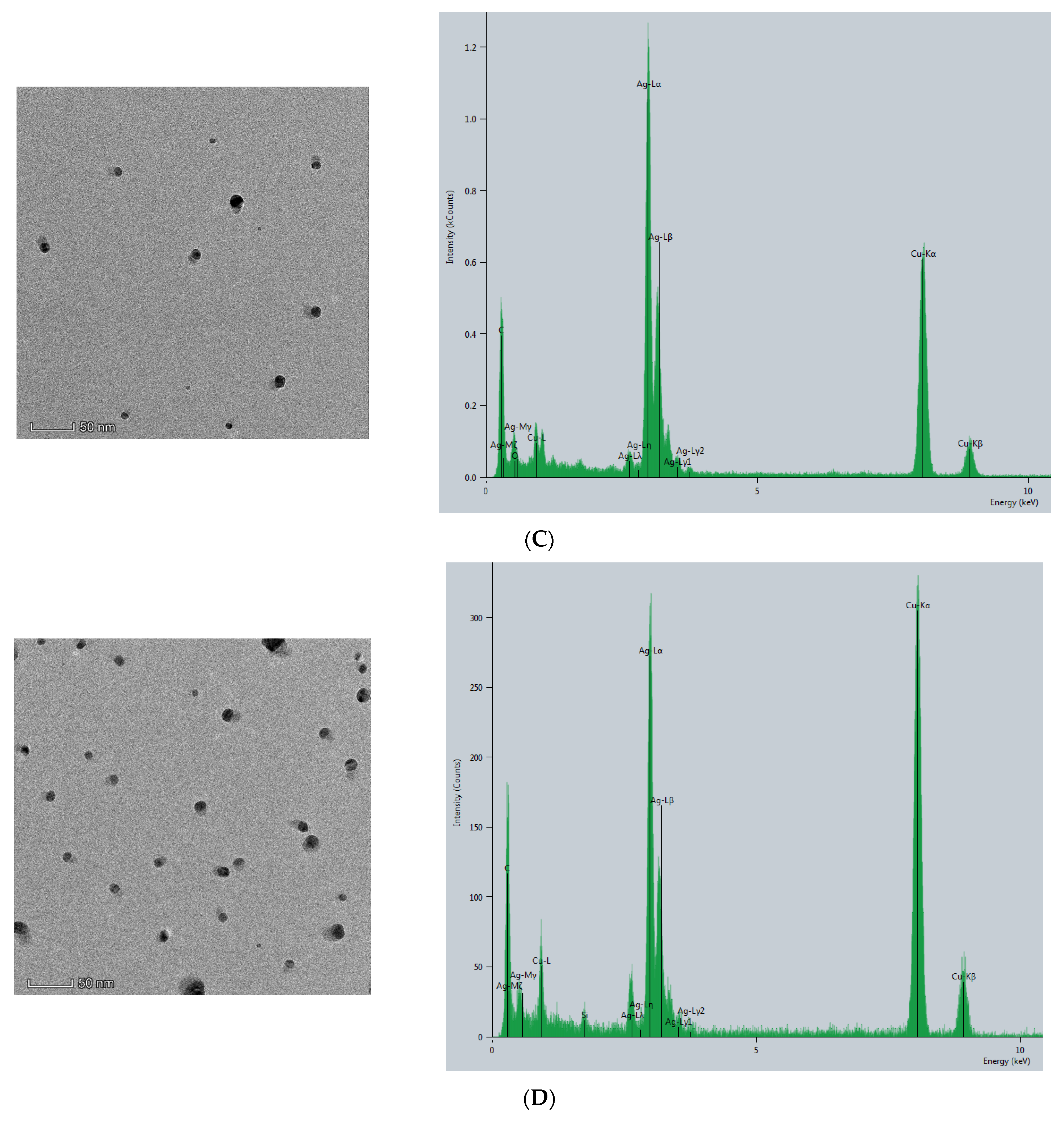

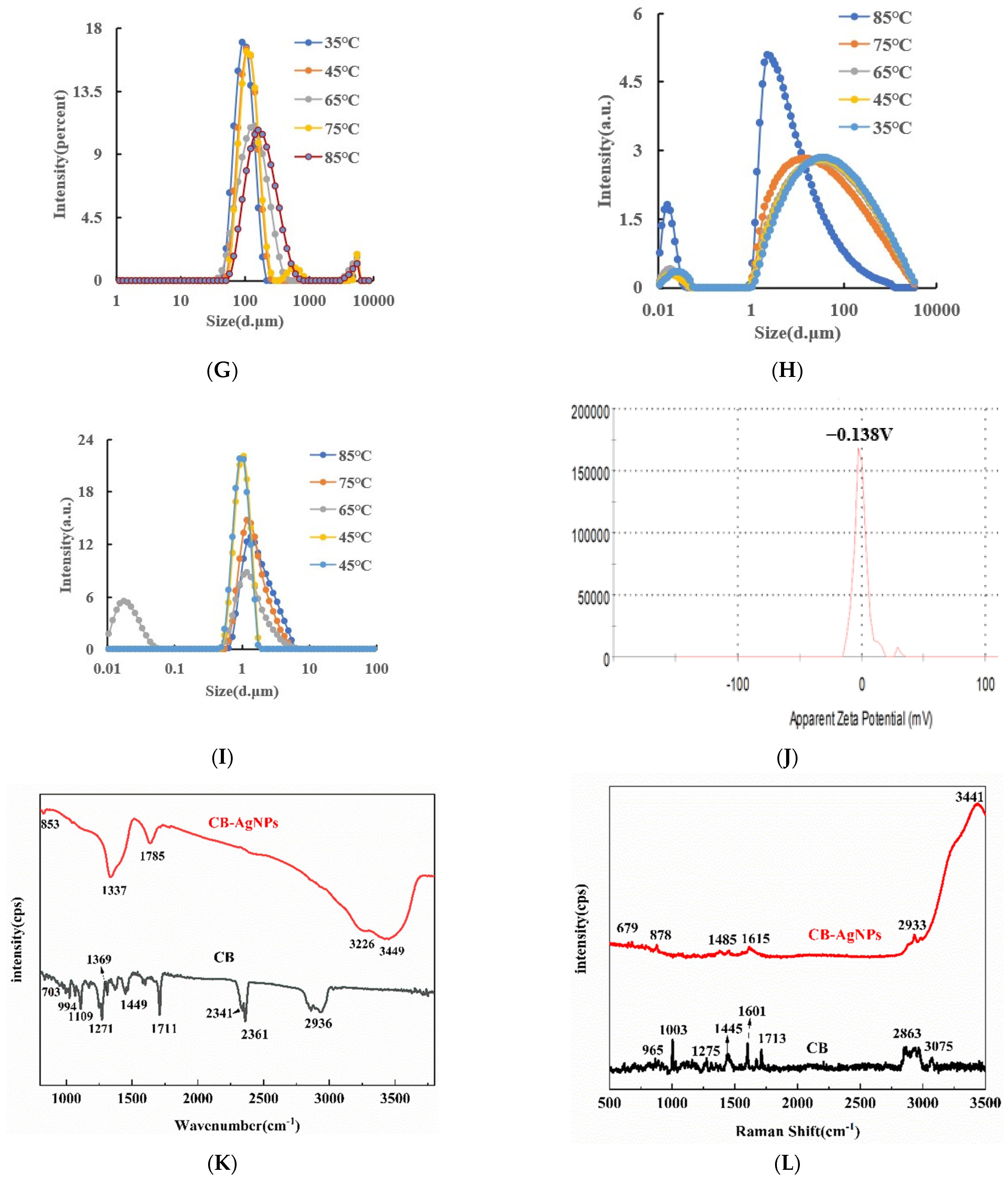
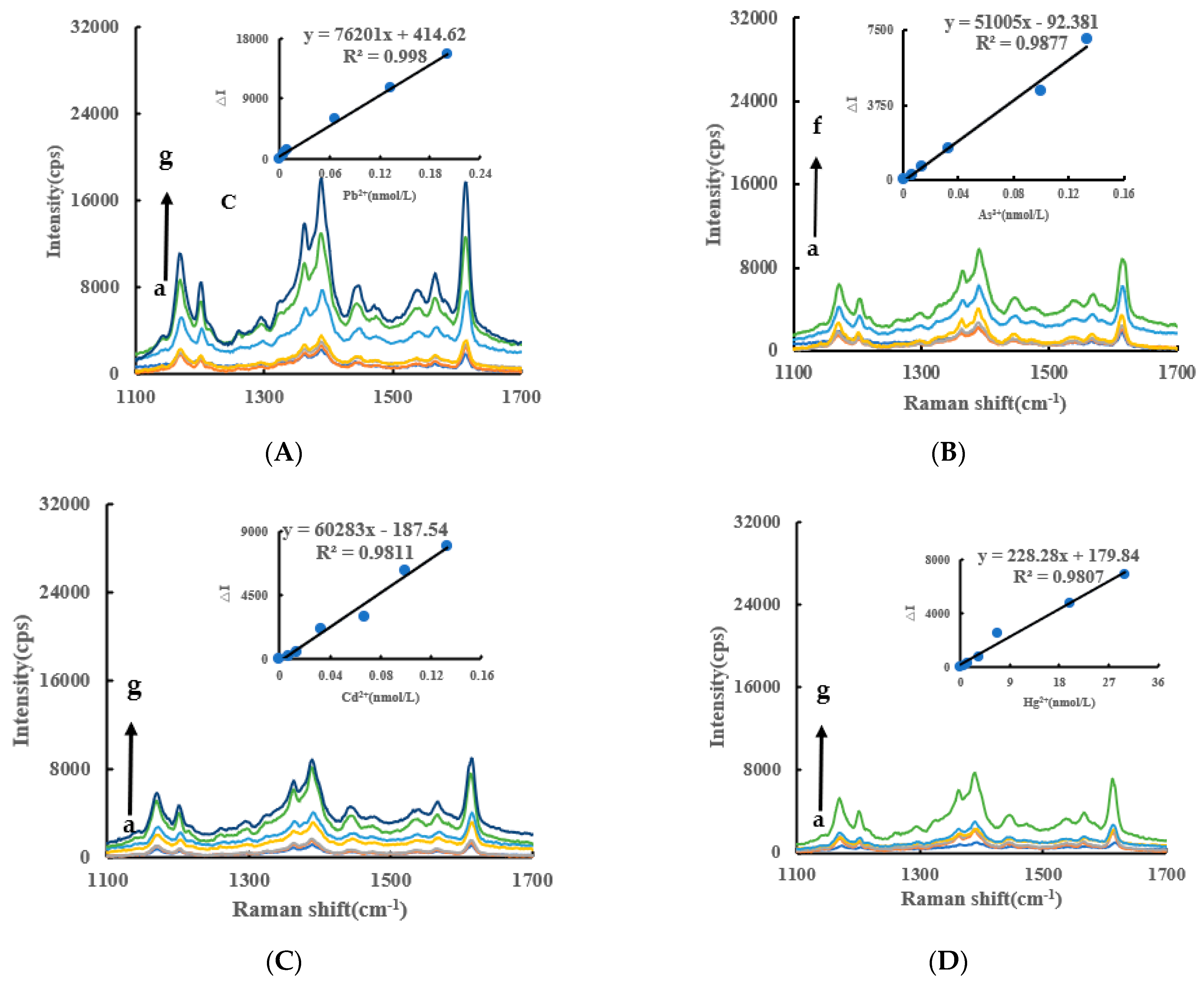
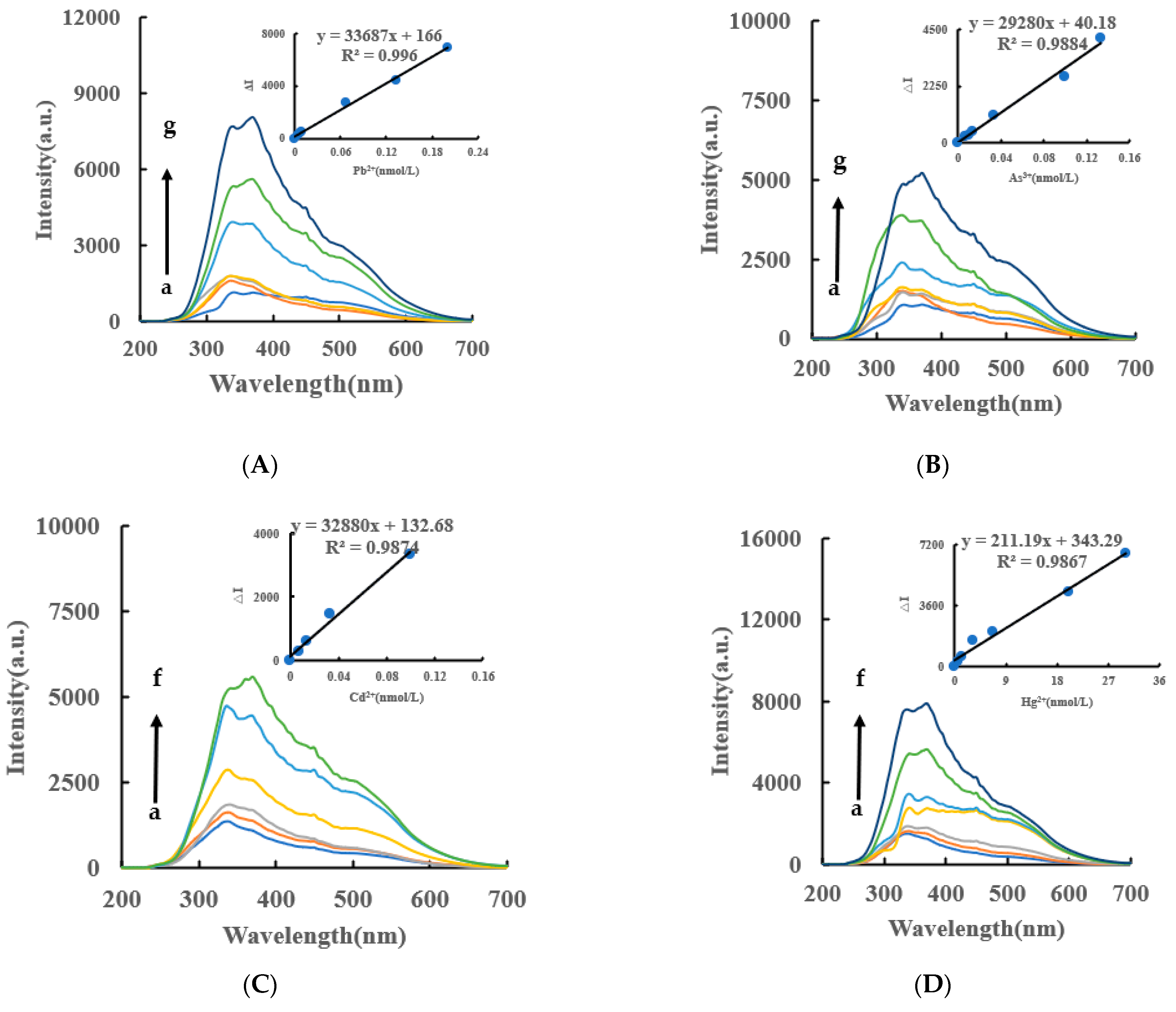
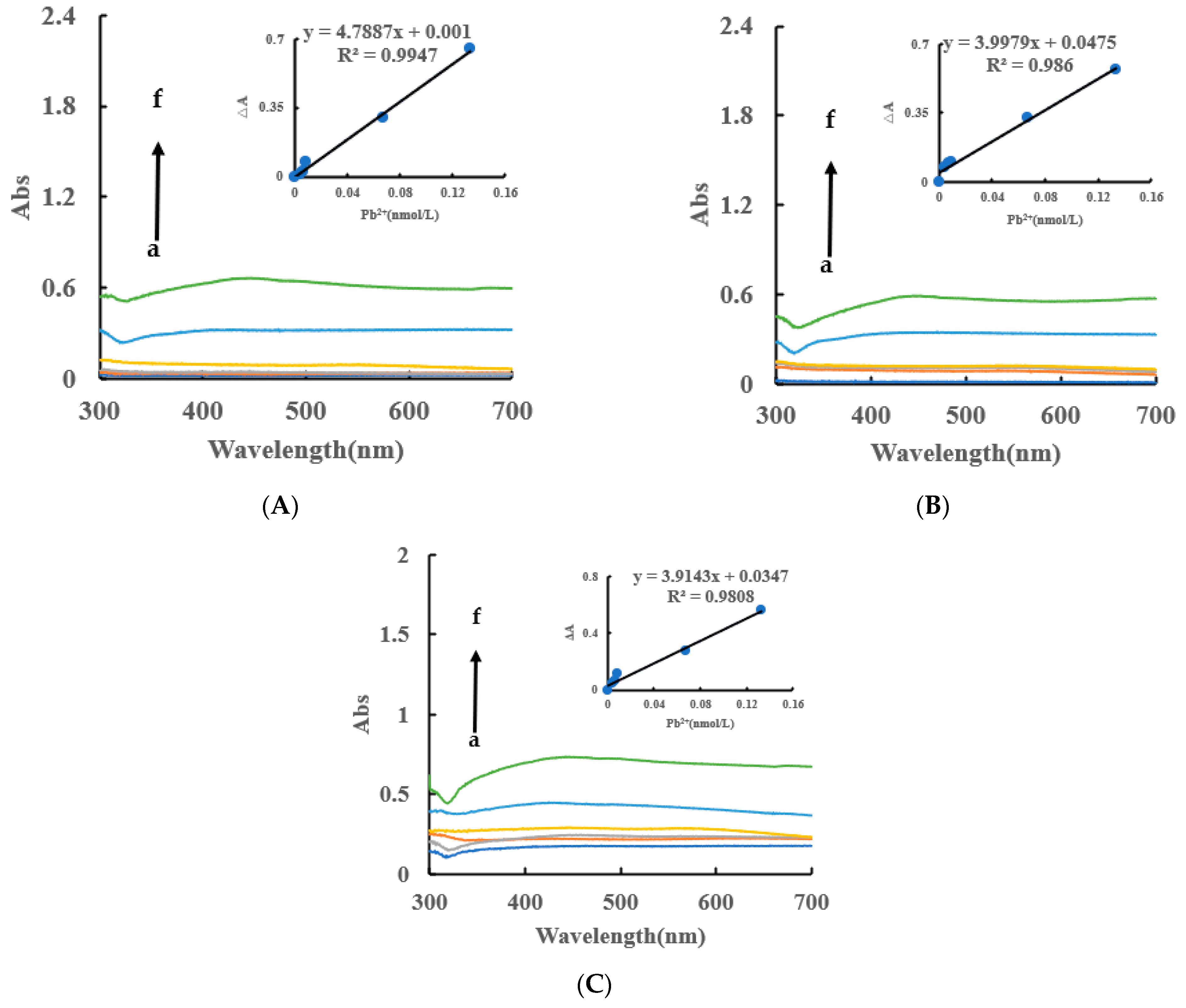
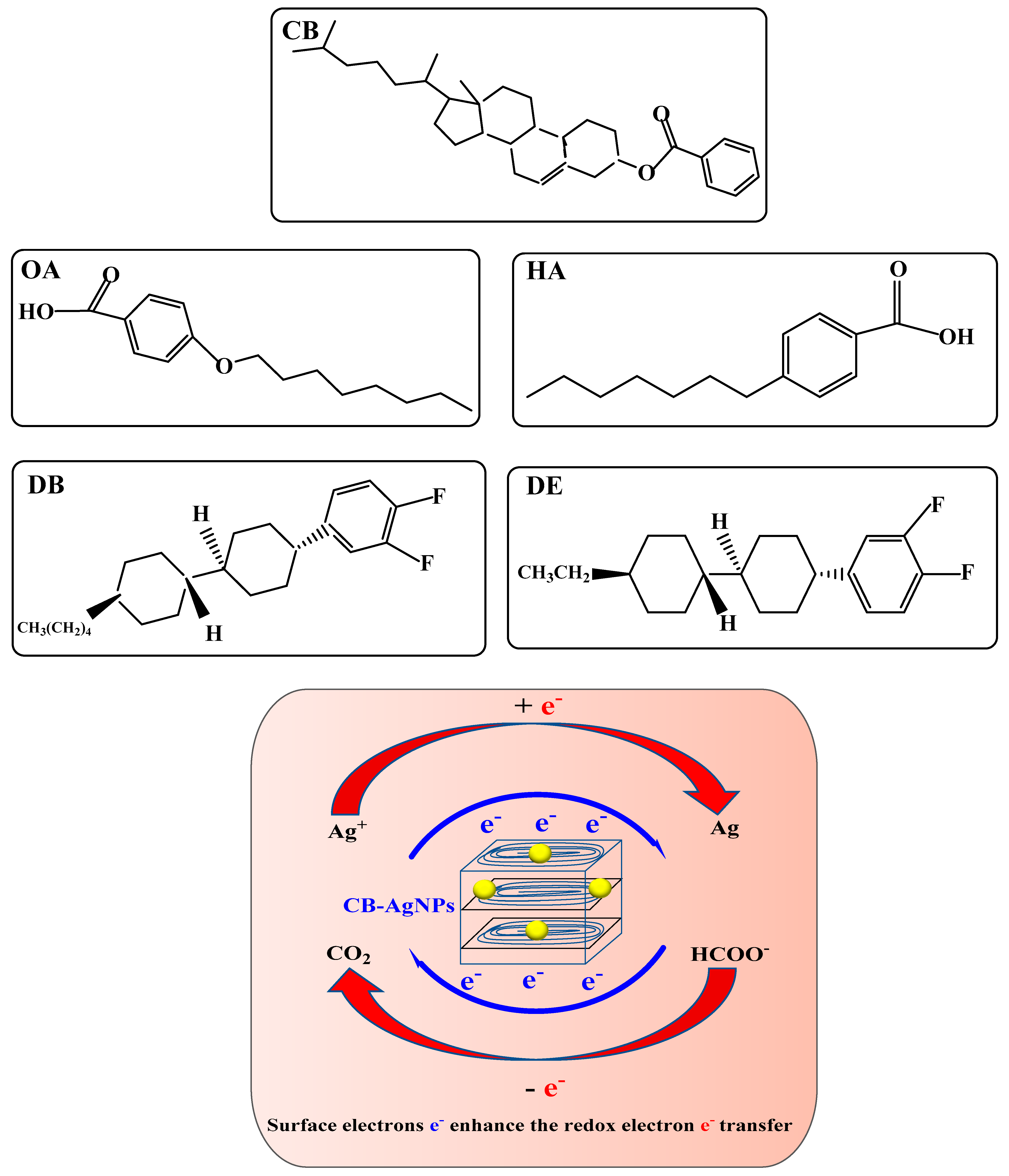
Disclaimer/Publisher’s Note: The statements, opinions and data contained in all publications are solely those of the individual author(s) and contributor(s) and not of MDPI and/or the editor(s). MDPI and/or the editor(s) disclaim responsibility for any injury to people or property resulting from any ideas, methods, instructions or products referred to in the content. |
© 2023 by the authors. Licensee MDPI, Basel, Switzerland. This article is an open access article distributed under the terms and conditions of the Creative Commons Attribution (CC BY) license (https://creativecommons.org/licenses/by/4.0/).
Share and Cite
Shu, Y.; Li, S.; Li, C.; Liang, A.; Jiang, Z. Liquid Crystal@Nanosilver Catalytic Amplification—Aptamer Trimode Biosensor for Trace Pb2+. Int. J. Mol. Sci. 2023, 24, 2920. https://doi.org/10.3390/ijms24032920
Shu Y, Li S, Li C, Liang A, Jiang Z. Liquid Crystal@Nanosilver Catalytic Amplification—Aptamer Trimode Biosensor for Trace Pb2+. International Journal of Molecular Sciences. 2023; 24(3):2920. https://doi.org/10.3390/ijms24032920
Chicago/Turabian StyleShu, Yiyi, Sha Li, Chongning Li, Aihui Liang, and Zhiliang Jiang. 2023. "Liquid Crystal@Nanosilver Catalytic Amplification—Aptamer Trimode Biosensor for Trace Pb2+" International Journal of Molecular Sciences 24, no. 3: 2920. https://doi.org/10.3390/ijms24032920
APA StyleShu, Y., Li, S., Li, C., Liang, A., & Jiang, Z. (2023). Liquid Crystal@Nanosilver Catalytic Amplification—Aptamer Trimode Biosensor for Trace Pb2+. International Journal of Molecular Sciences, 24(3), 2920. https://doi.org/10.3390/ijms24032920





